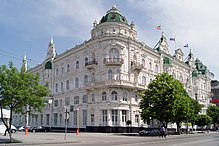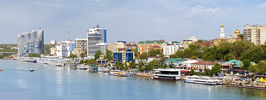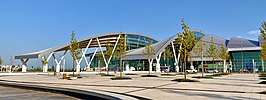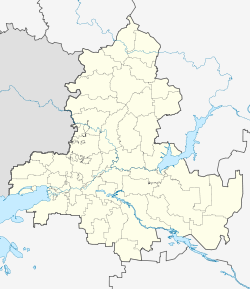
A | B | C | D | E | F | G | H | CH | I | J | K | L | M | N | O | P | Q | R | S | T | U | V | W | X | Y | Z | 0 | 1 | 2 | 3 | 4 | 5 | 6 | 7 | 8 | 9
Rostov-on-Don
Ростов-на-Дону | |
|---|---|
Clockwise from top: Don River embankment; Cathedral of the Nativity of the Theotokos; Gorky Drama Theatre; Platov Airport; Rostov Arena; and Rostov City Hall | |
| Coordinates: 47°13′21″N 39°42′36″E / 47.22250°N 39.71000°E | |
| Country | Russia |
| Federal subject | Rostov Oblast[1] |
| Founded | 1749[2] |
| City status since | 1796[2] |
| Government | |
| • Body | City Duma[3] |
| • Head[3] | Zinaida Neyarokhina[4] |
| Area | |
| • Total | 348.5 km2 (134.6 sq mi) |
| Elevation | 70 m (230 ft) |
| Population | |
| • Total | 1,089,261 |
| • Estimate (2018)[7] | 1,130,305 (+3.8%) |
| • Rank | 10th in 2010 |
| • Density | 3,100/km2 (8,100/sq mi) |
| • Subordinated to | Rostov-na-Donu Urban Okrug[1] |
| • Capital of | Rostov Oblast,[8] Rostov-na-Donu Urban Okrug[1] |
| • Urban okrug | Rostov-na-Donu Urban Okrug[9] |
| • Capital of | Rostov-na-Donu Urban Okrug[9] |
| Time zone | UTC+3 (MSK |
| Postal code(s)[11] | 344000–344002, 344004, 344006, 344007, 344009–344013, 344015, 344016, 344018–344023, 344025, 344029, 344030, 344032–344034, 344037–344039, 344041, 344045, 344048, 344050, 344052, 344055, 344056, 344058, 344064, 344065, 344068, 344069, 344072, 344079, 344082, 344090–344095, 344101, 344103, 344111–344114, 344116, 344700, 344880, 344890, 344899, 344960–344965, 344999, 901078, 995100 |
| Dialing code(s) | +7 863 |
| OKTMO ID | 60701000001 |
| City Day | Third Sunday of September[12] |
| Website | www |
Rostov-on-Don[a] is a port city and the administrative centre of Rostov Oblast and the Southern Federal District of Russia. It lies in the southeastern part of the East European Plain on the Don River, 32 kilometers (20 mi) from the Sea of Azov, directly north of the North Caucasus. The southwestern suburbs of the city lie above the Don river delta. Rostov-on-Don has a population of over one million people and is an important cultural centre of Southern Russia.
History
Early history
From ancient times, the area around the mouth of the Don River has held cultural and commercial importance. Ancient indigenous inhabitants included the Scythian and Sarmatian tribes. It was the site of Tanais, an ancient Greek colony, Fort Tana under the Genoese, and Fort Azak in the time of the Ottoman Empire.
In 1749, a custom house was established on the Temernik River, a tributary of the Don, by edict of the Empress Elizabeth, the daughter of Peter the Great,[2] in order to control trade with Turkey. It was co-located with a fortress named for Dimitry of Rostov, a metropolitan bishop of the old northern town of Rostov the Great. Azov, a town closer to the Sea of Azov on the Don, gradually lost its commercial importance in the region to the new fortress, but it remains an important historical center.[14]
In 1756, the "Russian commercial and trading company of Constantinople" was founded at the "merchants' settlement" (Kupecheskaya Sloboda) on the high bank of the Don. Towards the end of the eighteenth century, with the incorporation of previously Ottoman Black Sea territories into the Russian Empire, the settlement lost much of its militarily strategic importance as a frontier post.[14]
In 1796, the settlement was chartered and in 1797, it became the seat of Rostovsky Uyezd within Novorossiysk Governorate.[2] In 1806, it was officially renamed Rostov-on-Don.[2] During the 19th century, due to its river connections with Russia's interior, Rostov developed into a major trade centre and communications hub. A railway connection with Kharkiv was completed in 1870, with further links following in 1871 to Voronezh and in 1875 to Vladikavkaz.
Concurrent with improvements in communications, heavy industry developed. Coal from the Donets Basin and iron ore from Krivoy Rog supported the establishment of an iron foundry in 1846. In 1859, the production of pumps and steam boilers began. Industrial growth was accompanied by a rapid increase in population, with 119,500 residents registered in Rostov by the end of the nineteenth century along with approximately 140 industrial businesses. The harbour was one of the largest trade hubs in southern Russia, especially for the export of wheat, timber, and iron ore.
In 1779, Rostov-on-Don became associated with a settlement of Armenian refugees from Crimea at Nakhichevan-on-Don. The two settlements were separated by a field of wheat. In 1928, the two towns were merged. The former town border lies beneath the Teatralnaya Square of central Rostov-on-Don. By 1928, following the incorporation of the hitherto neighbouring city of Nakhichevan-on-Don, Rostov had become the third-largest city in Russia.
In the early 20th century, epidemics of cholera during the summer months were not uncommon.
20th century

During World War I Rostov-on-Don was briefly occupied by the German Empire in 1918.
During the Russian Civil War, the Whites and the Reds contested Rostov-on-Don, then the most heavily industrialized city of South Russia. By 1928, the regional government had moved from the old Cossack capital of Novocherkassk to Rostov-on-Don.
In the Soviet years, the Bolsheviks demolished two of Rostov-on-Don's principal landmarks: St. Alexander Nevsky Cathedral (1908) and St. George Cathedral (1783–1807).
During World War II, Nazi German forces occupied Rostov-on-Don, at first from 19/20 November to 2 December 1941,[15] after attacks by the German First Panzer Army in the Battle of Rostov, and then for seven months from 24 July 1942 to 14 February 1943. The town was of strategic importance as a railway junction and a river port accessing the Caucasus, a region rich in oil and minerals. It took ten years to restore the city from the damage during World War II.
In 1942 up to 30,000 Russian Jews were massacred by the German military in Rostov-on-Don at a site called Zmievskaya Balka.
21st century
On 19 March 2016, Flydubai Flight 981, a Boeing 737-800 operating from Dubai to Rostov-on-Don in Russia, crashed during a go-around in inclement weather at Rostov-on-Don Airport, killing all 62 people (55 passengers and 7 crew) on board.
Rostov-on-Don hosted several matches of the 2018 FIFA World Cup.
Rostov-on-Don is the location of the Russian Southern Military District, which includes the 58th Combined Arms Army. As such, it was a key logistical hub during the 2022 Russian invasion of Ukraine and the 2023 Ukrainian counteroffensive.[16]
On 23 June 2023, amid the conflict in Ukraine, the Wagner Group, a private military company fighting on behalf of the Russian Federation, declared a rebellion against the Russian Ministry of Defence and took control of Rostov-on-Don.[17] On June 24, after reaching a negotiated settlement with the Russian government and military, the Wagner Group withdrew from the city.[18]
Government

Within the framework of administrative divisions, it is incorporated as Rostov-na-Donu Urban Okrug—an administrative unit with the status equal to that of the districts.[1] As a municipal division, this administrative unit also has urban okrug status.[9]
City districts
Rostov-on-Don is divided into eight city districts:[19]
| No. | City District | Population Census |
|---|---|---|
| 1 | Voroshilovsky | 213,802 |
| 2 | Zheleznodorozhny | 102,044 |
| 3 | Kirovsky | 65,322 |
| 4 | Leninsky | 80,240 |
| 5 | Oktyabrsky | 165,874 |
| 6 | Pervomaysky | 180,061 |
| 7 | Proletarsky | 120,665 |
| 8 | Sovetsky | 175,725 |
Demographics
The 2021 census recorded the population of Rostov-on-Don at 1,142,162 making it the 11th most populous city in Russia.[20]
| Year | Pop. | ±% |
|---|---|---|
| 1897 | 119,000 | — |
| 1926 | 327,661 | +175.3% |
| 1939 | 502,928 | +53.5% |
| 1959 | 599,542 | +19.2% |
| 1970 | 788,827 | +31.6% |
| 1979 | 934,095 | +18.4% |
| 1989 | 1,019,305 | +9.1% |
| 2002 | 1,068,267 | +4.8% |
| 2010 | 1,089,261 | +2.0% |
| 2021 | 1,142,162 | +4.9% |
| Source: Census data | ||
At the time of the official 2010 Census, the ethnic makeup of the city's population whose ethnicity was known (1,066,523) was:[21]
| Ethnicity | Population | Percentage |
|---|---|---|
| Russians | 960,883 | 90.1% |
| Armenians | 41,553 | 3.4% |
| Ukrainians | 16,249 | 1.5% |
| Azerbaijanis | 6,739 | 0.6% |
| Tatars | 5,291 | 0.5% |
| Georgians | 3,960 | 0.4% |
| Belarusians | 2,874 | 0.3% |
| Koreans | 2,792 | 0.3% |
| Others | 26,182 | 2.5% |
Geography
Climate
Albert Parry, born in 1901 in Rostov-on-Don, wrote of the summers of his childhood:
- There were sultry days of brassy sun, but also cool evenings on the balconies facing the Don River, with the soft glow of charcoal in the samovar, with the ripe cherries crushed by your spoon against the bottom and sides of your glass of scalding tea.[22]
Rostov-on-Don lies in a humid continental climate (Köppen: Dfa).[23] The winter is moderately cold, with an average January temperature of −3.0 °C (26.6 °F). The lowest recorded temperature of −31.9 °C (−25.4 °F) occurred in January 1940.
Summers are warm and humid; July temperatures average +23.4 °C (74.1 °F). The city's highest recorded temperature of +40.2 °C (104.4 °F) was reported on 7 July 2020. The mean annual precipitation is 643 millimeters (25.3 in), the average wind speed is 2.7 m/s, and the average air humidity is 72%.[24]
| Climate data for Rostov-on-Don (1991–2020, extremes 1881–present) | |||||||||||||
|---|---|---|---|---|---|---|---|---|---|---|---|---|---|
| Month | Jan | Feb | Mar | Apr | May | Jun | Jul | Aug | Sep | Oct | Nov | Dec | Year |
| Record high °C (°F) | 15.0 (59.0) |
19.8 (67.6) |
26.0 (78.8) |
33.6 (92.5) |
35.6 (96.1) |
38.4 (101.1) |
40.2 (104.4) |
40.1 (104.2) |
38.1 (100.6) |
31.0 (87.8) |
25.0 (77.0) |
18.5 (65.3) |
40.2 (104.4) |
| Mean daily maximum °C (°F) | −0.1 (31.8) |
1.2 (34.2) |
7.8 (46.0) |
16.7 (62.1) |
22.9 (73.2) |
27.5 (81.5) |
30.2 (86.4) |
29.6 (85.3) |
23.1 (73.6) |
15.2 (59.4) |
6.6 (43.9) |
1.4 (34.5) |
15.2 (59.4) |
| Daily mean °C (°F) | −3.0 (26.6) |
−2.3 (27.9) |
3.1 (37.6) |
10.8 (51.4) |
17.0 (62.6) |
21.6 (70.9) |
24.0 (75.2) |
23.3 (73.9) |
17.1 (62.8) |
10.3 (50.5) |
3.1 (37.6) |
−1.3 (29.7) |
10.3 (50.5) |
| Mean daily minimum °C (°F) | −5.2 (22.6) |
−5.0 (23.0) |
−0.3 (31.5) |
6.1 (43.0) |
11.3 (52.3) |
15.7 (60.3) |
17.9 (64.2) |
17.5 (63.5) |
12.1 (53.8) |
6.5 (43.7) |
0.4 (32.7) |
−3.6 (25.5) |
Zdroj:https://en.wikipedia.org?pojem=Rostov_on_Don|












